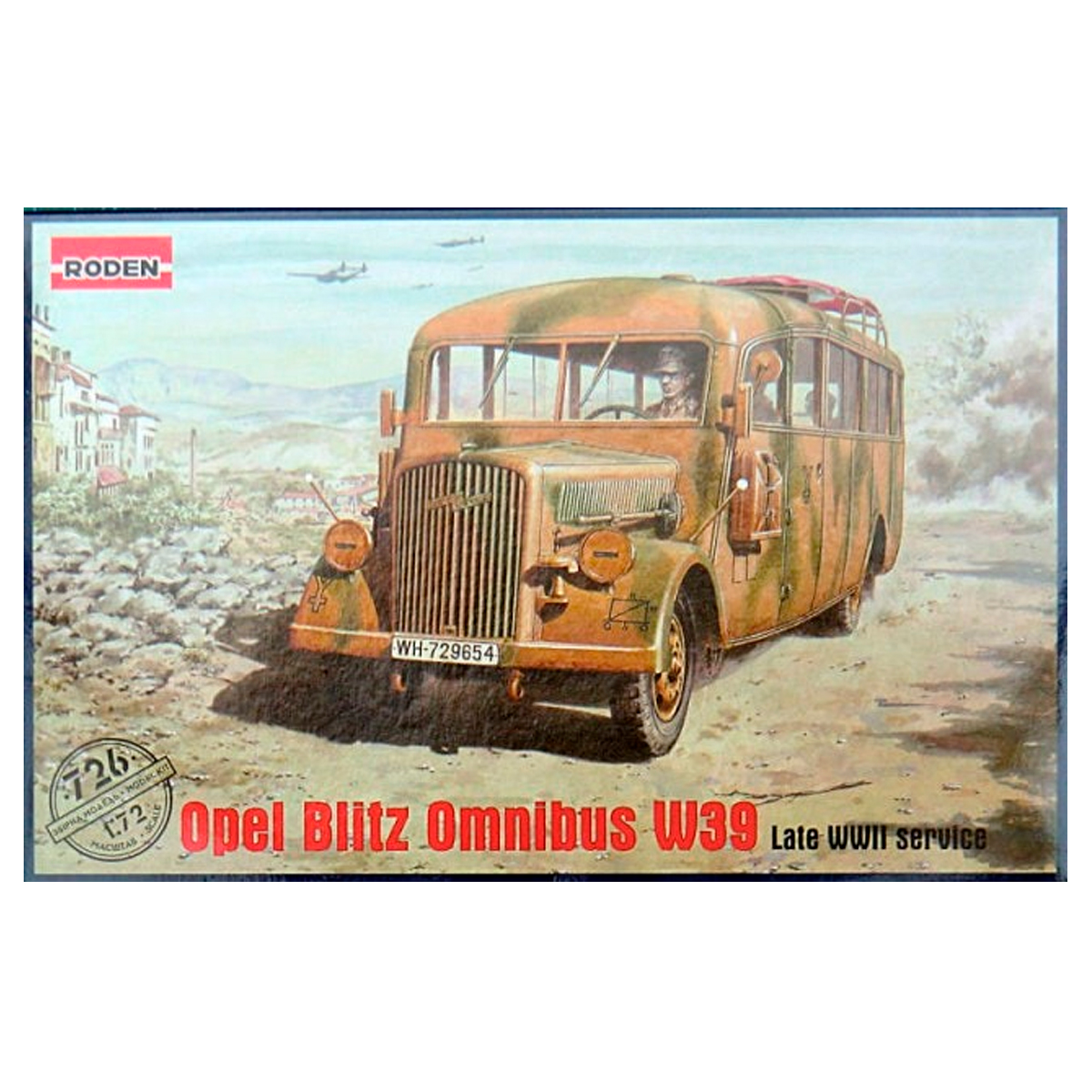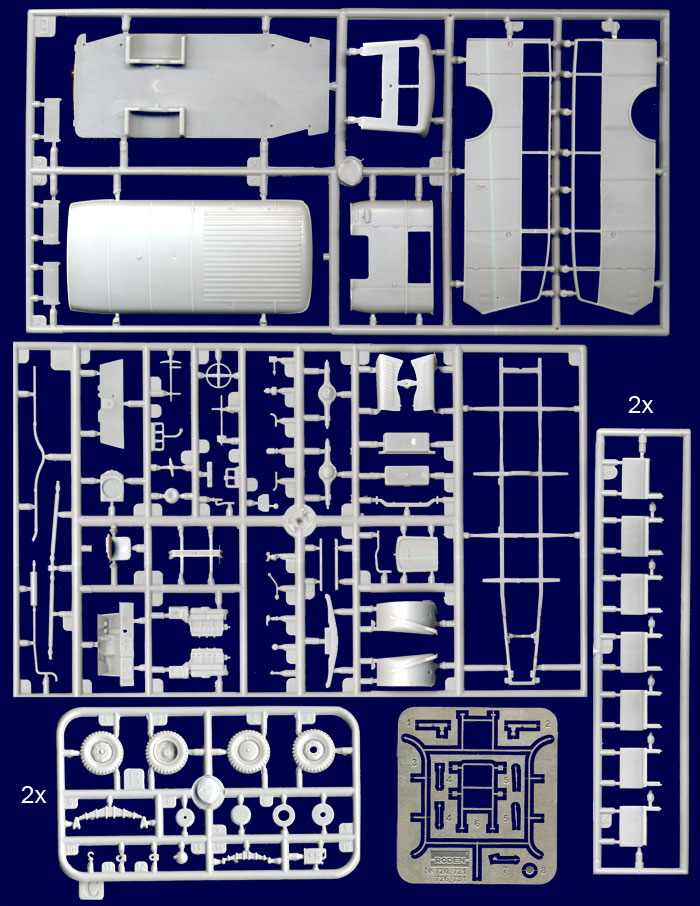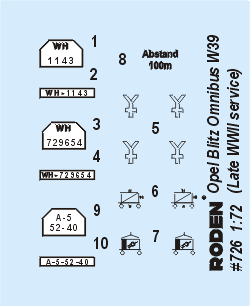1/72 Opel Blitz Omnibus W39 Late WWII service
12,40€
Solo quedan 1 disponibles

*Please check our Privacy Policies to see how to we use your personal data.
*Por favor revisa nuestra Política de Privacidad para ver como tratamos tus datos personales
Roden 1/72 Opel 3.6-47 Blitz Omnibus
In 1939 Germany was rapidly preparing for global hostilities. The plans of the German command supposed an instantaneous capture of quite large areas of other countries, and therefore special attention was paid to the question of the greatest possible motorization of infantry units. Besides a large number of different types of trucks which were already in the Wehrmacht’s inventory, staff buses also began to be taken on charge, whose main task was the conveyance of officers during offensive actions of the army with a likely prospect of minimal resistance by an opposing party in the conflict.
The practice of building buses on a truck’s chassis had existed for a long time, and therefore the most common types of buses which came into the German’s inventory were based on the most widely used trucks. One of the most popular trucks at this time was the well-known Opel Blitz, and on its chassis was designed a standard army bus (at the time the more common term for it was «omnibus»).
The Ludewig firm which was engaged in designing the bus, was located in Essen and had great experience in the manufacture of civilian multiseat vehicles. The standard chassis of the three ton truck was extended a little bit (up to 4450 mm), and the frame structure was reinforced. The original all-metal body of the new bus was quite elegant in outline, and only the front part where the engine was hidden, and the classic radiator with its distinctive logo, immediately reminded one of its predecessor, the famous «Blitz». Inside the cabin were several rows of seats which could be easily demounted if necessary (transportation of bulk goods, medical equipment, etc.).
Series production of the bus, officially designated the Opel 3.6-47 type W39, started in the second half of 1939, almost at the same time as the invasion of Poland by Germany and the start of WWII. At first, the number of vehicles produced per month was very small, but already in 1940 about one hundred units per month off were coming off the production line in Essen. Series production lasted until mid-1943, when the situation became worse for Germany at the Front, basic industrial materials were in short supply, and as a result, Ludewig had to seriously simplify the structure of the bus. During this period 2,880 units of the early version were produced overall, which were sent both to the Eastern Front in Russia, and to the Afrika Corps of General Rommel in North Africa.
A small number of early production buses were converted into mobile staff vehicles. For this purpose almost all of the passenger seats were removed and a few tables were fitted, for meetings in field conditions.
In addition, staff vehicles were equipped with various pieces of special equipment like telegraph machines, radios, ‘Enigma’ encryption machines, etc. A baggage rack of increased capacity was installed on top of the bus due to the need to transport large quantities of staff items. Buses sent to Rommel’s Afrika Corps additionally had extra metal shields on the side windows to shield the interior from the intense sunlight in hot desert conditions.
Staff vehicles were used in all theaters of war and played a full and definite role in active combat, especially in the early years of WWII.
/expand]
ESPAÑOL
Roden 1/72 Opel 3.6-47 Blitz Omnibus
En 1939 Alemania se preparaba rápidamente para las hostilidades mundiales. Los planes del mando alemán suponían la captura instantánea de zonas bastante extensas de otros países, por lo que se prestó especial atención a la cuestión de la mayor motorización posible de las unidades de infantería. Además de un gran número de diferentes tipos de camiones que ya se encontraban en el inventario de la Wehrmacht, también comenzaron a cargarse autobuses de Estado Mayor, cuya tarea principal era el transporte de oficiales durante las acciones ofensivas del ejército con una perspectiva probable de mínima resistencia por parte de un adversario en el conflicto.
La práctica de construir autobuses sobre el chasis de un camión existía desde hacía mucho tiempo, por lo que los tipos más comunes de autobuses que entraban en el inventario de los alemanes se basaban en los camiones más utilizados. Uno de los camiones más populares en aquella época era el conocido Opel Blitz, y sobre su chasis se diseñó un autobús militar estándar (en aquella época el término más común para él era «ómnibus»).
La empresa Ludewig, que se encargó de diseñar el autobús, estaba situada en Essen y tenía gran experiencia en la fabricación de vehículos civiles multistación. El chasis estándar del camión de tres toneladas se amplió un poco (hasta 4450 mm) y se reforzó la estructura del bastidor. La carrocería original totalmente metálica del nuevo autobús era de líneas bastante elegantes, y sólo la parte delantera, donde se ocultaba el motor, y el radiador clásico con su logotipo distintivo, recordaban inmediatamente a su predecesor, el famoso «Blitz». En el interior de la cabina había varias filas de asientos que podían desmontarse fácilmente en caso necesario (transporte de mercancías a granel, equipos médicos, etc.).
La producción en serie del autobús, denominado oficialmente Opel 3.6-47 tipo W39, comenzó en la segunda mitad de 1939, casi al mismo tiempo que la invasión de Polonia por Alemania y el inicio de la Segunda Guerra Mundial. Al principio, el número de vehículos producidos al mes era muy reducido, pero ya en 1940 salían de la línea de producción de Essen unas cien unidades mensuales. La producción en serie duró hasta mediados de 1943, cuando la situación empeoró para Alemania en el Frente, escaseaban los materiales industriales básicos y, como consecuencia, Ludewig tuvo que simplificar seriamente la estructura del autobús. Durante este periodo se fabricaron en total 2.880 unidades de la versión inicial, que se enviaron tanto al Frente Oriental en Rusia, como al Cuerpo Afrika del general Rommel en el norte de África.
Un pequeño número de los primeros autobuses de producción se convirtieron en vehículos móviles para el personal. Para ello, se retiraron casi todos los asientos de los pasajeros y se instalaron algunas mesas para celebrar reuniones sobre el terreno.
Además, los vehículos de personal se equiparon con diversos equipos especiales, como telégrafos, radios, máquinas de cifrado «Enigma», etc. Se instaló un portaequipajes de mayor capacidad en la parte superior del autobús debido a la necesidad de transportar grandes cantidades de artículos del personal. Los autobuses enviados al Cuerpo Afrika de Rommel tenían además protecciones metálicas adicionales en las ventanillas laterales para proteger el interior de la intensa luz del sol en las calurosas condiciones del desierto.
Los vehículos de Estado Mayor se utilizaron en todos los teatros de guerra y desempeñaron un papel pleno y definitivo en el combate activo, especialmente en los primeros años de la Segunda Guerra Mundial.






 Solicitud de ficha producto tipo SDS / Seguridad de producto
Solicitud de ficha producto tipo SDS / Seguridad de producto